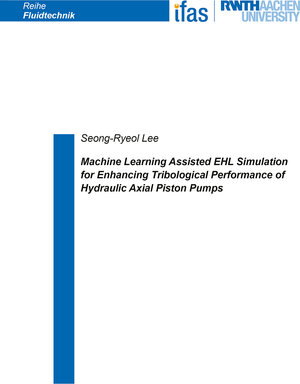
×
![Buchcover ISBN 9783819101083]()
Machine Learning Assisted EHL Simulation for Enhancing Tribological Performance of Hydraulic Axial Piston Pumps
von Seong-Ryeol LeeMachine Learning (ML) algorithms, a key aspect of Artificial Intelligence (AI), are increasingly applied across engineering to enhance performance via optimization. In hydraulics, AI-supported methods are gaining momentum, especially in system design, optimization, condition monitoring, and component development.
The aim of this thesis is to develop a conceptualization of the design process for hydraulic axial piston pumps using ML-assisted elasto-hydrodynamic lubrication (EHL) simulations. As an application example, a slipper in a high-speed axial piston pump is selected for validation in electro-hydraulic actuators (EHA). For this pur pose, the pump configuration and operating principle, as well as the tribological per formance at the slipper-swash plate contact, are explained.
The EHL simulation is described in detail, including the theoretical background, simulation configuration, calculation process, and meshing technique. The configu ration of a test bench for measuring the tribological performance of the slipper to validate the EHL simulation is explained, and a cross-validation of the measurement data and simulation results is performed.
The second part the work applies Bayesian optimization to improve slipper design. Selected design parameters serve as variables, with tribological performance as the objective. Additionally, a k-means clustering method is used to classify component operating conditions. By integrating real-world scenarios, an optimal design is achieved within predefined boundaries.
The aim of this thesis is to develop a conceptualization of the design process for hydraulic axial piston pumps using ML-assisted elasto-hydrodynamic lubrication (EHL) simulations. As an application example, a slipper in a high-speed axial piston pump is selected for validation in electro-hydraulic actuators (EHA). For this pur pose, the pump configuration and operating principle, as well as the tribological per formance at the slipper-swash plate contact, are explained.
The EHL simulation is described in detail, including the theoretical background, simulation configuration, calculation process, and meshing technique. The configu ration of a test bench for measuring the tribological performance of the slipper to validate the EHL simulation is explained, and a cross-validation of the measurement data and simulation results is performed.
The second part the work applies Bayesian optimization to improve slipper design. Selected design parameters serve as variables, with tribological performance as the objective. Additionally, a k-means clustering method is used to classify component operating conditions. By integrating real-world scenarios, an optimal design is achieved within predefined boundaries.


